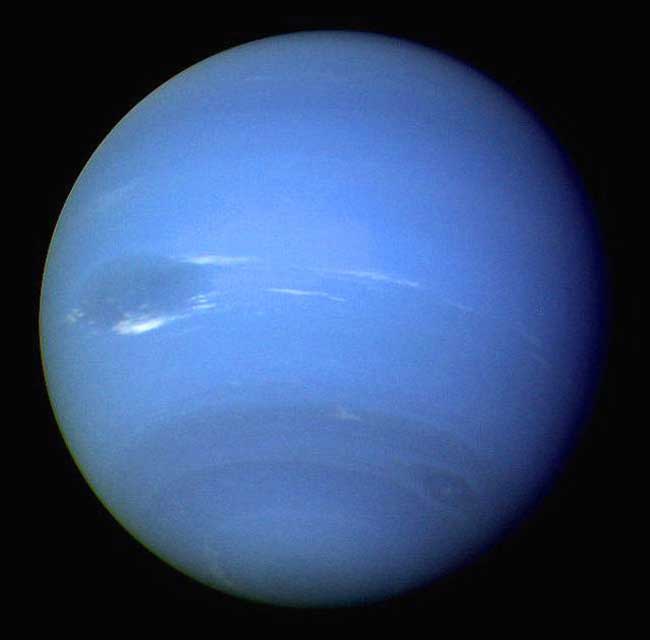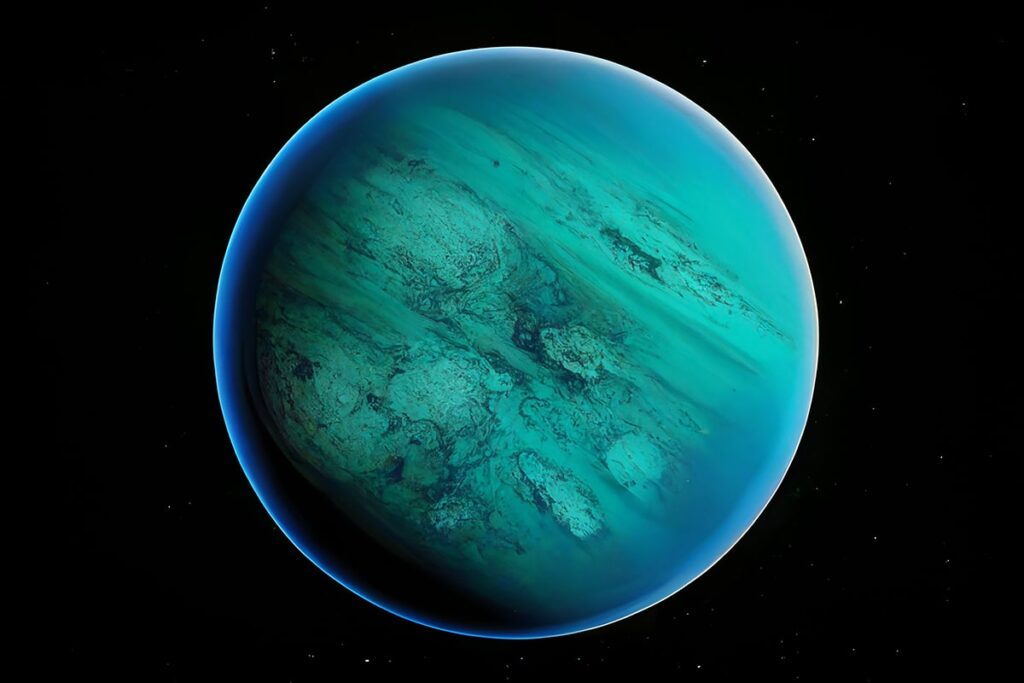- The sun: Neptune is the eighth planet from the sun. The distance from Neptune to the sun is approximately 4.5 trillion km – about 30 times the distance from Earth to the sun
- Day: 1 day on Neptune (the time it takes the planet to revolve around itself once) lasts 16 hours
- Year: 1 year on Neptune (the time it takes the planet to revolve once around the sun) is equivalent to 165 years here on Earth
- Surface: Like the other gas giants, Jupiter and Saturn, Neptune has no solid surface. Neptune is primarily a very thick combination of water, ammonia and methane covering a solid core the size of Earth
- Atmosphere: Neptune’s atmosphere consists mainly of hydrogen, helium and methane. Neptune has 6 rings and a magnetic field about 27 times stronger than Earth’s
- Gravity: Neptune’s gravity is only 17% stronger than Earth’s. This means that Neptune is the planet whose gravity is most similar to Earth’s
- Moons: Neptune has 13 moons, all of which are named after various sea gods and nymphs from Greek mythology. A 14th moon was discovered in 2013, but is awaiting approval from the International Astronomical Union
- Triton: Triton – the largest of Neptune’s moons – is extremely cold with a surface temperature of -235 degrees Celsius. It is covered by a thin atmosphere that is constantly getting warmer (no one knows why)
- Extreme winds: Winds on Neptune can be 5-6 times stronger than here on Earth. In 1989, Voyager 2 tracked a large, oval-shaped dark storm in Neptune’s southern hemisphere. The storm was rotating counterclockwise, in a westerly direction at nearly 2,400 km/h and was called “the Great Dark Spot”. The storm was large enough to encompass the entire Earth.
- Name: The name Neptune has its origins in Roman mythology, where Neptune was the god of fresh water and the sea. The discoverer of Neptune, Johann Gottfried Galle, wanted the planet to be named after its predictor, Urbain Joseph Le Verrier, but the International Astronomical Union (IAU) would not approve

Fact: Winds on Neptune can reach speeds of up to 2,400 km/h – on Earth, 408 km/h is the maximum measured speed. Pictured is The Great Dark Spot, which was a storm with a similar speed
More facts about Neptune
- Liv: Life – as we know it – cannot exist on Neptune
- Size: Neptune has a volume approximately 58 times greater than Earth. Its mass is about 17 times greater. Together with Uranus, Neptune is also known as one of the two ice giants. In addition, Neptune is also one of the four gas giants (Jupiter, Saturn, Uranus and Neptune)
- Circulation: The small planet Pluto has a highly eccentric orbit that coincides with Neptune’s. This happens for a period of 20 years every 248 years. However, Pluto can never collide with Neptune because Pluto only manages to rotate twice around the sun for every 3 rotations of Neptune. The last time Pluto was in Neptune’s orbit was in the period 1979-1999
- The most distant planet: Neptune is the most distant planet – which is a title with a bit of history behind it: originally, Neptune was the most distant planet. In 1930, Pluto was discovered and became the most distant planet. However, between 1979-1999, Pluto was closer to the sun than Neptune (due to its eccentric orbit) and Neptune became the most distant planet again. After this, Pluto repeated the title. However, in 2006, the International Astronomical Union decided that Pluto can no longer be defined as a planet; so Neptune once again became the most distant, which it remains today


